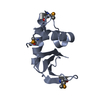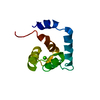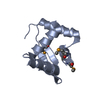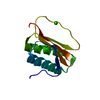[English] 日本語
 Yorodumi
Yorodumi- PDB-2m4e: Solution NMR structure of VV2_0175 from Vibrio vulnificus, NESG t... -
+ Open data
Open data
- Basic information
Basic information
| Entry | Database: PDB / ID: 2m4e | ||||||
|---|---|---|---|---|---|---|---|
| Title | Solution NMR structure of VV2_0175 from Vibrio vulnificus, NESG target VnR1 and CSGID target IDP91333 | ||||||
 Components Components | Putative uncharacterized protein | ||||||
 Keywords Keywords | UNKNOWN FUNCTION / pathogenic bacterial protein / Structural Genomics / PSI-Biology / Northeast Structural Genomics Consortium / NESG / Ontario Centre for Structural Proteomics / OCSP / Center for Structural Genomics of Infectious Diseases / CSGID | ||||||
| Function / homology | Uncharacterised protein PF16691 family / Protein of unknown function DUF5062 / DUF5062 superfamily / Domain of unknown function (DUF5062) / Four Helix Bundle (Hemerythrin (Met), subunit A) / Up-down Bundle / Mainly Alpha / DUF5062 domain-containing protein / Uncharacterized protein Function and homology information Function and homology information | ||||||
| Biological species |  Vibrio vulnificus (bacteria) Vibrio vulnificus (bacteria) | ||||||
| Method | SOLUTION NMR / simulated annealing | ||||||
| Model details | lowest energy, model1 | ||||||
 Authors Authors | Wu, B. / Yee, A. / Houliston, S. / Lemak, A. / Garcia, M. / Savchenko, A. / Arrowsmith, C.H. / Anderson, W.F. / Northeast Structural Genomics Consortium (NESG) / Ontario Centre for Structural Proteomics (OCSP) / Center for Structural Genomics of Infectious Diseases (CSGID) | ||||||
 Citation Citation |  Journal: To be Published Journal: To be PublishedTitle: Solution NMR structure of VV2_0175 from Vibrio vulnificus, NESG target VnR1 and CSGID target IDP91333 Authors: Wu, B. / Yee, A. / Houliston, S. / Lemak, A. / Garcia, M. / Savchenko, A. / Arrowsmith, C.H. | ||||||
| History |
|
- Structure visualization
Structure visualization
| Structure viewer | Molecule:  Molmil Molmil Jmol/JSmol Jmol/JSmol |
|---|
- Downloads & links
Downloads & links
- Download
Download
| PDBx/mmCIF format |  2m4e.cif.gz 2m4e.cif.gz | 545 KB | Display |  PDBx/mmCIF format PDBx/mmCIF format |
|---|---|---|---|---|
| PDB format |  pdb2m4e.ent.gz pdb2m4e.ent.gz | 456.7 KB | Display |  PDB format PDB format |
| PDBx/mmJSON format |  2m4e.json.gz 2m4e.json.gz | Tree view |  PDBx/mmJSON format PDBx/mmJSON format | |
| Others |  Other downloads Other downloads |
-Validation report
| Summary document |  2m4e_validation.pdf.gz 2m4e_validation.pdf.gz | 538.3 KB | Display |  wwPDB validaton report wwPDB validaton report |
|---|---|---|---|---|
| Full document |  2m4e_full_validation.pdf.gz 2m4e_full_validation.pdf.gz | 721 KB | Display | |
| Data in XML |  2m4e_validation.xml.gz 2m4e_validation.xml.gz | 37.5 KB | Display | |
| Data in CIF |  2m4e_validation.cif.gz 2m4e_validation.cif.gz | 57.2 KB | Display | |
| Arichive directory |  https://data.pdbj.org/pub/pdb/validation_reports/m4/2m4e https://data.pdbj.org/pub/pdb/validation_reports/m4/2m4e ftp://data.pdbj.org/pub/pdb/validation_reports/m4/2m4e ftp://data.pdbj.org/pub/pdb/validation_reports/m4/2m4e | HTTPS FTP |
-Related structure data
| Similar structure data | |
|---|---|
| Other databases |
- Links
Links
- Assembly
Assembly
| Deposited unit | 
| |||||||||
|---|---|---|---|---|---|---|---|---|---|---|
| 1 |
| |||||||||
| NMR ensembles |
|
- Components
Components
| #1: Protein | Mass: 12274.192 Da / Num. of mol.: 1 Source method: isolated from a genetically manipulated source Source: (gene. exp.)  Vibrio vulnificus (bacteria) / Strain: CMCP6 / Gene: VV2_0175 / Production host: Vibrio vulnificus (bacteria) / Strain: CMCP6 / Gene: VV2_0175 / Production host:  |
|---|
-Experimental details
-Experiment
| Experiment | Method: SOLUTION NMR | ||||||||||||||||||||||||||||||||||||||||||||||||||||||||||||||||||||
|---|---|---|---|---|---|---|---|---|---|---|---|---|---|---|---|---|---|---|---|---|---|---|---|---|---|---|---|---|---|---|---|---|---|---|---|---|---|---|---|---|---|---|---|---|---|---|---|---|---|---|---|---|---|---|---|---|---|---|---|---|---|---|---|---|---|---|---|---|---|
| NMR experiment |
|
- Sample preparation
Sample preparation
| Details |
| ||||||||||||||||||||||||||||||||||||||||||||||||||||||||||||
|---|---|---|---|---|---|---|---|---|---|---|---|---|---|---|---|---|---|---|---|---|---|---|---|---|---|---|---|---|---|---|---|---|---|---|---|---|---|---|---|---|---|---|---|---|---|---|---|---|---|---|---|---|---|---|---|---|---|---|---|---|---|
| Sample |
| ||||||||||||||||||||||||||||||||||||||||||||||||||||||||||||
| Sample conditions | Ionic strength: 300 / pH: 7 / Pressure: ambient / Temperature: 298 K |
-NMR measurement
| NMR spectrometer |
|
|---|
- Processing
Processing
| NMR software |
| ||||||||||||||||||||||||||||||||||||||||
|---|---|---|---|---|---|---|---|---|---|---|---|---|---|---|---|---|---|---|---|---|---|---|---|---|---|---|---|---|---|---|---|---|---|---|---|---|---|---|---|---|---|
| Refinement | Method: simulated annealing / Software ordinal: 1 Details: The heterogeneity of viv0002 expressed in Escherichia coli BL21 (DE3) was observed. Three extra peaks in 15N HSQC and more than 25 extra peaks in 13C HSQC were identified. These peaks are ...Details: The heterogeneity of viv0002 expressed in Escherichia coli BL21 (DE3) was observed. Three extra peaks in 15N HSQC and more than 25 extra peaks in 13C HSQC were identified. These peaks are grouped into three fragments, one assigned as GlcNAc, the other two fragments could not be accurately assigned given the limited information we have, but they are likely to belong to glycans. These fragments display intra NOEs only and remain solvent exposed with strong and narrow line widths. NMR relaxation data showed that these unknown modifications are highly mobile and no interaction with viv0002. Heterologously expressed viv0002 was confirmed by LC-MS. A mass shift of 178 Da of 15N-labeled viv0002 was detected whereas a shift of 72 Da for 13C/15N-labeled sample. However, neither of results matches any three unknown fragments seen in the NMR spectrum with MW 202 Da, 155 Da and 204 Da, respectively. The nature and functional consequence of the unknown fragments/modifications to viv0002 are not understood at this stage. The structure deposited provides the basis of the future investigation. | ||||||||||||||||||||||||||||||||||||||||
| NMR constraints | NOE constraints total: 2122 / NOE intraresidue total count: 384 / NOE long range total count: 687 / NOE medium range total count: 649 / NOE sequential total count: 402 / Hydrogen bond constraints total count: 70 / Protein chi angle constraints total count: 0 / Protein other angle constraints total count: 0 / Protein phi angle constraints total count: 57 / Protein psi angle constraints total count: 57 | ||||||||||||||||||||||||||||||||||||||||
| NMR representative | Selection criteria: lowest energy | ||||||||||||||||||||||||||||||||||||||||
| NMR ensemble | Conformer selection criteria: structures with the lowest energy Conformers calculated total number: 100 / Conformers submitted total number: 20 |
 Movie
Movie Controller
Controller










 PDBj
PDBj HNCA
HNCA